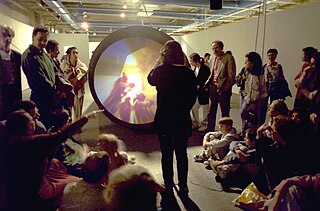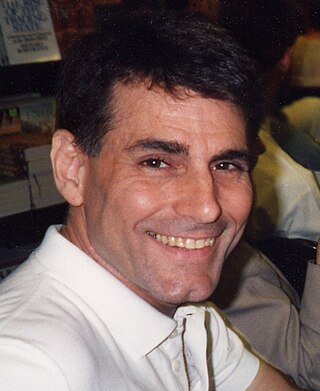Related Research Articles

Digital art refers to any artistic work or practice that uses digital technology as part of the creative or presentation process. It can also refer to computational art that uses and engages with digital media.

Interactive art is a form of art that involves the spectator in a way that allows the art to achieve its purpose. Some interactive art installations achieve this by letting the observer walk through, over or around them; others ask the artist or the spectators to become part of the artwork in some way.
Software art is a work of art where the creation of software, or concepts from software, play an important role; for example software applications which were created by artists and which were intended as artworks. As an artistic discipline software art has attained growing attention since the late 1990s. It is closely related to Internet art since it often relies on the Internet, most notably the World Wide Web, for dissemination and critical discussion of the works. Art festivals such as FILE Electronic Language International Festival, Transmediale (Berlin), Prix Ars Electronica (Linz) and readme have devoted considerable attention to the medium and through this have helped to bring software art to a wider audience of theorists and academics.

Rafael Lozano-Hemmer is a Mexican-Canadian electronic artist living and working in Montreal, Quebec, Canada. He creates platforms for public participation by using robotic lights, digital fountains, computerized surveillance, and telematic networks. Inspired by phantasmagoria, carnival, and animatronics, his interactive works are “anti-monuments for people to self-represent.”
The conservation and restoration of new media art is the study and practice of techniques for sustaining new media art created using from materials such as digital, biological, performative, and other variable media.
Daniel Rozin is an Israeli-American artist working in the area of interactive digital art. As an interactive artist Rozin creates installations and sculptures that have the unique ability to change and respond to the presence and point of view of the viewer. In many cases the viewer becomes the contents of the piece and in others the viewer is invited to take an active role in the creation of the piece.
Matthew Ritchie is a British artist who currently lives and works in New York City. He attended the Camberwell School of Art from 1983 to 1986. He describes himself as "classically trained" but also points to a minimalist influence. His art revolves around a personal mythology drawn from creation myths, particle physics, thermodynamics, and games of chance, among other elements.

Casey Edwin Barker Reas, also known as C. E. B. Reas or Casey Reas, is an American artist whose conceptual, procedural and minimal artworks explore ideas through the contemporary lens of software. Reas is perhaps best known for having created, with Ben Fry, the Processing programming language.

Golan Levin is an American new media artist, composer, performer and engineer interested in developing artifacts and events which explore supple new modes of reactive expression.
Jon Thomson and Alison Craighead are London-based visual artists, who work with video, sound and the internet.
Shredder 1.0 is a work of Net Art created by Mark Napier. The Shredder 1.0 interface takes preexisting websites and deconstructs their code to create original abstract compositions.

Internet art is a form of new media art distributed via the Internet. This form of art circumvents the traditional dominance of the physical gallery and museum system. In many cases, the viewer is drawn into some kind of interaction with the work of art. Artists working in this manner are sometimes referred to as net artists.
Lia is an Austrian software artist. Born in Graz, she is now based in Vienna. Her work includes the early Net Art sites re-move.org and turux.at. In 2003 she co-curated the Abstraction Now exhibition at the Künstlerhaus Wien in Vienna, Austria. In 2003 Lia received an Award of Distinction in the Net Vision/Net Excellence Category for re-move.org.

Timothy Binkley, is an American philosopher, artist, and teacher, known for his writings about conceptual art and aesthetics, as well as several essays that helped to define computer art. He is also known for his interactive art installations from the late 1980s and early 1990s.

Erased de Kooning Drawing (1953) is an early work of American artist Robert Rauschenberg. This conceptual work presents an almost blank piece of paper in a gilded frame. It was created in 1953 when Rauschenberg erased a drawing he obtained from the abstract expressionist and American artist Willem de Kooning. Rauschenberg's friend and fellow artist Jasper Johns later framed it in a gilded frame and added a written caption to mimic the framing style of the Royal Academy and monogramming found on Renaissance drawings and prints. The caption reads: "Erased de Kooning Drawing, Robert Rauschenberg, 1953". It has been in the collection of the San Francisco Museum of Modern Art (SFMOMA) since 1998. SFMOMA describes the work as a "drawing [with] traces of drawing media on paper with a label and gilded frame."

Pae White is an American multimedia visual artist known for her unique portrayal of nature and mundane objects through her creations of suspended mobiles. She currently lives and works between Sonoma County and Los Angeles, California.
The conservation and restoration of performance art is the process of documenting, collecting, and prolonging the life of Performance Art. Performance Art often features a live presentation initially documented by an artist, cultural institution, or host location. This genre of art can take place in a wide range of mediums, and is usually based on four core elements: Time, Space, the Performer's body, and the relationship between viewers and performer. These variables determine how it can be collected and conserved within museums or cultural institutions.
Craig Kalpakjian is an American artist working in New York, known for his computer-generated, photo-realistic renderings of anonymous, institutional spaces. He is considered one of the first artists of his generation to make digital images depicting entirely artificial spaces in a fine art context.
Siebren Versteeg is an American artist known for his painting and video works created through digital processes. His multivalent practice responds to the technology of our time and the way we consume and deploy those technologies.
Prema Murthy is an American, multi-disciplinary artist based in New York. Employing aesthetics, gesture, geometry and algorithmic processes, Murthy's work explores the boundaries between embodiment and abstraction, while engaging in issues of culture and politics. Her work has been exhibited nationally and internationally at MoMA PS1, the Whitney Museum of American Art, the New Museum of Contemporary Art, the Reina Sofia Museum, the Generali Foundation in Vienna, and the India Habitat Center-New Delhi.
References
- Mark Napier's official website
- Interview with Mark Napier by Tilman Baumgaertel
- Interview with Mark Napier by Jon Ippolito, January 2002
- Interview with Mark Napier by Andreas Broegger
- 010101: Art in Technological Times (catalog), pp. 112–113
- Tilman Baumgartel, net.art 2.0, Kunst Nurnberg, pp. 182–191
- Christiane Paul, Digital Art, Thames & Hudson Ltd
- Ebon Fisher, Wigglism Leonardo Journal 40, No. I, p. 40
- New Media Art by Mark Tribe and Reena Jana, Taschen p. 70
- From Steel to Software by Lauren Cornell, [ permanent dead link ]
- Lieser, Wolf. Digital Art. Langenscheidt: h.f. ullmann. 2009 pp. 46–49
- Interview of Mark Napier by Kristine Feeks,Spring 2001
- Mark Napier's official website biography